Finnish national parks
Finnish National Parks are found in most parts of the country. In addition to national parks some other protected areas are presented below, as well as national hiking areas and the wilderness areas of Finnish Lapland.
Finland has a diverse nature, with forests, fells, mires, bogs, lakes and islands featuring in many of the parks. In a few parks the interaction between Man and nature is a central theme. As Finland is sparsely populated, one can often be alone with nature in the less known parks and in remote areas even of popular parks.
Understand

The parks are open to the public without any entry or hiking fees. Many have services such as marked hiking trails, cottages, goahtis and saunas for rent. The right to access is usually somewhat restricted in the parks, but the offered free services should compensate that for most visitors. National parks and strict nature reserves are always on state owned land, but other protected areas may be on ground owned by other entities, even privately owned.
There are nature trails in most of the areas listed below. In nearly all but the smallest areas, there are locations for rest (with campfire sites and pit toilets) and in the bigger ones hiking trails and some lodging facilities (often lean-to shelters, in the north more commonly open wilderness huts, in popular areas also rental cabins).
Berry and mushroom picking is usually allowed, in regard to edible species. Taking anything else from the nature is usually forbidden in national parks and nature reserves. Dogs must be kept on leash with few exceptions; you may see people letting their dog free, but even a friendly dog can wreak havoc, especially among nesting birds.
Information is usually available in English, but some (such as most information boards along nature trails) may be in Finnish only, or Finnish and either Swedish or Sami.
Most of the really large parks are in the far north, in the Sami native region. Regulations of the parks try not to disturb the traditional livelihood of the Sami. Thus e.g. reindeer herding, hunting, fishing, taking wood for own needs and even driving are often allowed for the locals also where forbidden otherwise. The local population is sparse enough that this does not generally threaten the ecology of the areas.
National parks, hiking areas and wilderness areas
National parks are the prime destinations for those wanting to see Finnish nature other than normal countryside. They are always on state owned land where the nature is deemed to be of general interest as a sight or for education. New parks have an area of at least 10 km2 (3.9 sq mi), several being much larger. The largest, Lemmenjoki National Park, has an area of 2 860 km² and borders the Norwegian Øvre Anárjohka nationalpark of 1 409 km² and some wilderness areas. There are often some restrictions to the right to access: collecting stones, plants (other than edible mushrooms and berries) or insects is usually forbidden, wild camping is allowed only in certain areas and entry to some locations may be restricted. Service, such as trails, shelters and campfire places more than compensates for this for most visitors. Acquaint yourself to the rules of the park in question, especially if you are not just walking marked trails. The parks are maintained by Metsähallitus, the Finnish forestry administration.
The national hiking areas are specifically for hiking and for acquainting oneself to the nature of the region, offering quite large versatile and unspoiled areas. The nature may not be unique enough to be in need of protection, but often worth seeing indeed. There is good infrastructure, such as hiking trails, campfire places and lean-to and cooking shelters. The right to access also usually applies. The areas are maintained by Metsähallitus.
The wilderness areas were protected 1991 to preserve their wilderness character, the Sami culture and the Sami natural form of livelihood. There are twelve such areas, all of which are located in Lapland. There is little service in the areas themselves (but often tourist businesses nearby, arranging service on request) and the right to access usually applies in full. They are of interest especially for experienced hikers who are used to making their own paths. There may be some marked trails, but if so, they cover only part of the area. If there are skiing routes in winter, only the markings are maintained, not the tracks themselves.
These areas are all listed below.
Nature reserves and other areas
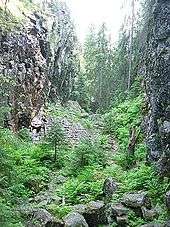
The selection below of nature reserves and other areas is somewhat arbitrary. The ones listed are deemed to be of interest also to the casual visitor, some as a destination in themselves, some worth a visit if you happen to pass by.
Recreation areas are usually maintained by the municipality. They may have good infrastructure like the national hiking areas, often also facilities for outdoor sports and sometimes camping sites and the like. They are not listed here, but may be mentioned in the city articles.
The strict nature reserves are primarily for nature protection and research. There are often information boards and trails through them though, and larger reserves may have other infrastructure, such as pit toilets and shelters for rest and overnight stays (often just outside the protected area itself). Hiking is restricted to marked trails at least part of the year. As the right to access is severely restricted, you should check the rules of the individual area. They are mostly small, some suitable for a trip of a few hours, some for a weekend, but there are also bigger areas, an extreme being the Kevo canyon with a 64 km trail.
Entry to bird nesting areas is often prohibited in the bird nesting season, but there may be towers for bird watching and trails and other service in the neighbourhood or in less sensitive parts of the area.
There are also many areas for protection of specific types of nature or specific features of the nature, such as mire, old-growth forest and esker protection areas. These typically have no restrictions relevant for visitors, other than on any land, but you should probably be careful about not causing erosion or wildfire and not to harm plants and wildlife.
Hiking trails
There are trails through most of the areas listed below. In some areas (especially nature reserves and restricted areas of national parks) only the marked trails may be used. In hiking, recreation and wilderness areas the right to access usually applies without restrictions.
There are usually nature trails and short easy trails at the visitor centre or some other trailhead of the more popular areas, such as most national parks, some even meant for use also with pram or wheelchair (assisted – grades are often still quite steep), and nature trails or hiking trails suitable for day trips in most areas. In the hiking areas, larger national parks and in many wilderness areas there are also trails for overnight hikes. There are quite a few trails also for several days' hiking and – especially in wilderness areas and backcountry of national parks – many visitors hike independent of any trails.
In addition to the hiking trails and nature trails inside national parks and similar, there are longer hiking trails and networks of hiking trails extending much outside some protected areas, sometimes leading through several. If you are going for a longer hike, anywhere but in the largest parks, it might be worthwhile to include some of the unprotected countryside landscape by using such trails. They usually keep to areas in natural condition where possible, but often also utilise forest roads and similar. Combining trails you can spend weeks on your hike in e.g. eastern Finland. The most famous trail is Karhunkierros of 82 km. The longest trail of the Walks in North Karelia network is 133 km. The UKK trail, though not complete or well documented, goes from Koli in Lieksa all the way to the Urho Kekkonen National Park in Lapland (more than 500 km by bird's flight). The Nordkalottleden, which crosses borders to Norway and Sweden, is 800 km long. Some of the trails are described by Metsähallitus. Trails of 40–60 km are common.
Destinations
You are free to explore the landscape more or less everywhere, thanks to the so called Every man's right (jokamiehenoikeus, allemansrätten), the right to access. There is usually plenty of undeveloped land also near cities, and most cities have recreational areas. The destinations listed here, as outlined above, are worth some more travelling.
Southern Finland
.jpg)
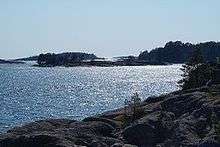
National parks in Southern Finland
- Gulf of Finland National Park : includes hundreds of islands and islets in the Baltic Sea outer archipelago in front of the towns of Kotka and Hamina.
- Ekenäs Archipelago National Park : starting point is the town of Ekenäs. The national park itself consists of islands, which are accessible by boat only. Canoe or kayak is a great means of transport between the islands, but requires some experience. Otherwise you can e.g. use a taxi boat.
- Liesjärvi National Park : forests, mires and lake shores south of Forssa. Torronsuo National Park is nearby.
- Nuuksio National Park: unspoiled piece of nature within Helsinki metropolitan region; landscapes with valleys and gorges formed by the Ice Age, lakes, and barren rocky hills covered by lichen and sparse pine forest. Wonderful place for weekend hiking and camping in the capital area.
- Päijänne National Park : located in the southern part of lake Päijänne, Finland's second largest lake, about 45 km north of Lahti. Some of the islands can be reached by road.
- Sipoonkorpi National Park : located within the municipalities of Sipoo, Vantaa and Helsinki about 20 km from the centre of Helsinki. The area includes different forest types, mires and cultural landscapes.
- Torronsuo National Park : the area south of Forssa (close to Liesjärvi National Park) mostly consists of mire.
- Valkmusa National Park : located on of the main road E18 near Kotka. It mainly consists of mire landscapes.
Hiking areas in Southern Finland
- Evo National Hiking Area: largest continuous forested areas in southern Finland; Hämeenlinna, Padasjoki
Other destinations in Southern Finland
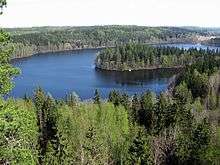
- Aulanko nature reserve with park and national landscape, suitable for day trips; Hämeenlinna.
- Karkali: herb-rich forest area on a peninsula in Lohjanjärvi; Lohja
- Komio: ridges and other signs of the ice age, good hiking destination with diverse nature; Loppi
- Laajalahti: shallow sea bay, bird wetland; Espoo
- Langinkoski: rapids, arboretum, fishing hut of the tsar; Kotka
- Melkuttimet: ridge-side pine forests and lakes; Loppi and Tammela
- Siikalahti Wetland: Finland’s most valuable inland bird wetland; Parikkala
West coast area


National parks in the West Coast area
- Archipelago National Park in the Archipelago Sea, the largest archipelago in the world by count of islands and islets. Kimitoön and Pargas, 500 km².
- Bothnian Sea National Park : bird sanctuaries and outer archipelago with lighthouses, underwater nature and rocky islands. Eurajoki, Kustavi, Merikarvia, Pori, Pyhäranta, Rauma and Uusikaupunki.
- Kauhaneva-Pohjankangas National Park : large open bogs and dry pine forests. Kauhajoki and Karvia, 62 km².
- Kurjenrahka National Park: the largest and most diverse protected mire area in Southwest Finland, the park also includes old-growth forest. Turku, Aura, Masku, Mynämäki, Nousiainen, Pöytyä and Rusko, 29 km².
- Lauhanvuori National Park : high hill with peculiar geology. Kauhajoki, Isojoki and Honkajoki, 54 km².
- Puurijärvi-Isosuo National Park : large mires and important bird lake. Kokemäki, Huittinen and Sastamala, 27 km².
- Teijo National Park : lakes, rocks and forests by a sea bay and two historic ironworks villages. Salo.
Other destinations in the West Coast area
Finnish Lakeland
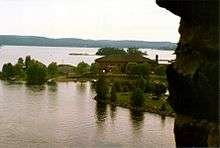

National parks in Finnish Lakeland
- Helvetinjärvi National Park : wild forest landscape with deep gorges. Hiking trail to Seitseminen National Park, some 50 km if hiking through both national parks, the trail continues. Ruovesi, 49,5 km².
- Isojärvi National Park : peaceful forest and lake landscapes, suitable also for canoe tours. Kuhmoinen, 22 km².
- Koli National Park: versatile nature and cultural landscape in a relatively small area, versatile services, lookout points that inspired many of the people forming the Finnish national identity before the independence, in Lieksa, Joensuu and Kontiolahti
- Kolovesi National Park: in the Saimaa lake complex, in Enonkoski, Heinävesi and Savonlinna
- Leivonmäki National Park: easy trails through diverse landscape. Joutsa, 30 km²
- Linnansaari National Park: in the Saimaa lake complex, in Rantasalmi, Savonlinna and Varkaus
- Patvinsuo National Park: mires, old growth forests and waterways, beavers and waterfowl, in Lieksa and Ilomantsi
- Petkeljärvi National Park: , small park with lakes, ridges, old trees and a fen meadow, battle trenches from the 1940s, the starting point of the old 31 km Taitajan taival trail, in Ilomantsi
- Pyhä-Häkki National Park: : old-growth forests and trees of great age. Saarijärvi, 13 km².
- Repovesi National Park: rugged backwoods with lakes, log floating history, popular hiking destination, in Kouvola and Mäntyharju
- Salamajärvi National Park: rugged watershed region of Suomenselkä. Kivijärvi, Kinnula, Perho, 62 km².
- Seitseminen National Park : forests, mires and eskers. Hiking trail to Helvetinjärvi National Park, some 50 km if hiking through both national parks, the trail continues. Ylöjärvi and Ikaalinen, 45,5 km².
- Tiilikkajärvi National Park: sandy beaches of lake Tiilikka, mires and forests, transition zone with northern and southern natural features, in Rautavaara and Sotkamo
Hiking areas in Finnish Lakeland
- Ruunaa National Hiking Area hiking, cycling, cross-country skiing, canoeing and white water rafting, by the Russian border, in Lieksa
Other destinations in Finnish Lakeland
- Walks in North Karelia (Karelian Circuit), including also some biking and skiing routes
- Kermajärvi: lake and national landscape, reachable by boat only; Heinävesi
- Kolvananuuro: geologycally interesting area with special vegetation and a half day's demanding nature trail; Kontiolahti
- Kurimonkoski Rapids: scenic rapids by former ironworks, meadows maintained to keep the traditional landscape; Utajärvi
- Olvassuo: wide and diverse mire area spotted with forest islets; Pudasjärvi, Puolanka, Utajärvi
- Pihlajavesi: national landscape, labyrinthic lakeland; Sulkava
- Punkaharju: nature reserve and national landscape; lake views through pine forest of the esker ridge; Savonlinna
- Telkkämäki: slash-and-burn heritage farm; Kaavi
- Vaarunvuoret: old pine forests growing on rocky hills with many endangered species; Jyväskylä
- Vehoniemenharju: esker between two large lakes, landscape featuring in Sommardag i Kangasala by Topelius; Kangasala
National parks in the former Oulu province
- Bothnian Bay National Park (Perämeri National Park): primarily for experienced boaters, in Kemi and Tornio
- Hiidenportti National Park: in Sotkamo: watershed area with the Hiidenportti gorge, old forest and former sites of tar burning, log driving and slash-and-burn farming; 45 km²
- Hossa National Park in Suomussalmi, with pine forests, lakes, eskers and stone age rock paintings; 110 km²
- Oulanka National Park: see national landscape even in a few hours; Kuusamo, Salla
- Rokua National Park: in Muhos, Utajärvi and Vaala
- Syöte National Park: in Pudasjärvi, Taivalkoski and Posio
Hiking areas in the former Oulu province
Other destinations in the former Oulu province
- Karhunkierros: legendary and popular 80 km hiking trail, mostly through Oulanka National Park.
- Elimyssalo: varied forest nature with wilderness farms by the UKK trail, central part of the Finnish-Russian Friendship Park; Kuhmo.
- Hepoköngäs: Finland's highest natural waterfall and old-growth forest by the UKK trail; Puolanka.
- Hirvisuo: vast open aapa mires and birds, in Oulu. Birdwatching tower and nature trail accessible from national road 20.
- Kurimonkoski Rapids: scenic rapids by former ironworks, meadows maintained to keep the traditional landscape; Utajärvi
- Lentua: rugged, wilderness-like nature, known through Akseli Gallen-Kallela, part of the Finnish-Russian Friendship Park; Kuhmo
- Näränkä: virtually pristine nature, mostly forests, and wilderness farm; Kuusamo
- Teerisuo-Lososuo: mires and old-growth forests, by Hiidenportti National Park and the UKK trail; Kuhmo
- Valtavaara-Pyhävaara by Ruka and the Karhunkierros trail: nature reserve with spectacular views and challenging cross-country skiing trails; Kuusamo
Lapland

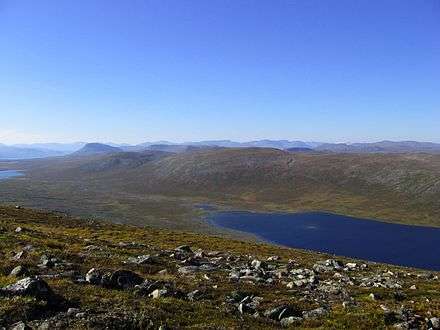
National parks in Lapland
- Lemmenjoki National Park: Lemmenjoki river valley, gold digging, wast backcountry, in Inari and Kittilä
- Pallas-Yllästunturi National Park: fells surrounded by forests and mires, transition zone between the southern forested region and Fell Lapland, in Enontekiö, Kittilä, Kolari and Muonio
- Pyhä-Luosto National Park: magnificent landscape and peace, versatile services; Eastern Lapland: Pelkosenniemi, Kemijärvi, Sodankylä
- Riisitunturi National Park: fell and hill landscape, colourful hanging bogs; Posio
- Urho Kekkonen National Park: both easily available parts and wast backcounty, in Inari, Sodankylä and Savukoski
Hiking areas in Lapland
Wilderness areas
- Hammastunturi Wilderness Area
- Kaldoaivi Wilderness Area
- Kemihaara Wilderness Area
- Käsivarsi Wilderness Area
- Muotkatunturit Wilderness Area
- Paistunturi Wilderness Area
- Pulju Wilderness Area
- Pöyrisjärvi Wilderness Area
- Tarvantovaara Wilderness Area
- Tsarmitunturi Wilderness Area
- Tuntsa Wilderness Area
- Vätsäri Wilderness Area
Other destinations in Lapland
- Nordkalottleden: 800 km hiking trail through Arctic landscapes in Norway, Finland and Sweden.
- Auttiköngäs: old-growth forests, varied terrain and a high waterfall, suitable for day trips; Rovaniemi.
- Ilmakkiaapa: aapa mires with rich birdlife; Sodankylä.
- Iso-Palonen - Maariansärkät: eskers by the UKK trail, part of the Finnish-Russian Friendship Park.
- Juortanansalo-Lapinsuo: mire and forest wilderness by the UKK trail, part of the Finnish-Russian Friendship Park; Kuhmo, Suomussalmi.
- Kevo: nature reserve with 40 km canyon in northern Lapland; Utsjoki
- Korouoma: old-growth and herb rich forests, rugged landscapes with a canyon; Posio
- Luiro Mires: large fen mires and raised bogs, internationally significant bird habitat; Pelkosennemi and Savukoski
- Malla: nature reserve, protected 1916, geologically interesting with rare plants; by the Finland-Norway-Sweden tripoint near Kilpisjärvi
- Martimoaapa: important mire protection and bird area, old-growth forests; Keminmaa
- Simojärvi and Soppana: easy and nice hiking; Ranua, Posio
- Sompio: a nature reserve by Urho Kekkonen National Park; forests, fells and mires; Sodankylä
- Teuravuoma-Kivijärvenvuoma: mires, important bird habitat, villages; Kolari
- Viiankiaapa: vast flark fens, diverse mire nature, birds; Sodankylä
Get in

Most of the national parks, national hiking areas and wilderness areas are reachable by car and by public transportation. A taxi ride can be worth its price for freer choosing of endpoints of a hike, and needed for getting to some trailheads without car or an extra day of hiking. There are seldom roads into the destination itself.
A few of the national parks cover archipelago areas, either in the lakes or by the coast. They are best explored by kayak or boat, but usually some parts are reachable by road or ferry. Kayaks, canoes and boats suitable for the destination can usually be rented. If you are not confident commanding your own vessel, at least taxi boat services are available.
There are visitor centres, Metsähallitus customer service points and nature information huts, where you can get advice, maps, some literature, fishing permits and an introduction to the area.
The visitor centres are usually outside the main entrance of national parks, but sometimes quite a distance from the destinations. At some national parks there are hotels, ski resorts or other big tourist businesses by the visitor centre.
The visitor centres are usually accessible by wheelchair, if assisted, as are a few nature trails.
For destinations other than national parks there are not necessarily any obvious visitor centres. Wilderness areas are usually handled by other visitor centres in the area, like some other destinations. For some areas not administered by Metsähallitus you may have to do some research to find the responsible entity and people able to give information on it.
Fees
Just visiting an area, hiking and camping does not involve any fees. Some campgrounds may have fees, but they are never the only or even main option when on a hike.
You might want to pay for transport, equipment, a guided tour, a rental hut, a guaranteed bed in a reservation hut or a fishing permit.
Get around

There are usually nature trails and hiking trails in the areas, especially near the visitor centres, as well as maintained skiing tracks in the winter. Except in nature reserves you are usually allowed to find your own paths. In the archipelago and by some rivers you might want to use a boat or kayak.
At most parks it is possible to get a guide through the businesses the park is cooperating with. This is especially useful if you are uncertain about your skills, but the guide can be useful also by knowing the nature, culture and sights and by being able to arrange meals, boat tours and similar.
The nature trails and other shorter (day trip) trails are usually well maintained, have duckboards at wet terrain and bridges at waterways, so that no special equipment is needed in the normal season. In spring (when the snow is melting), in rainy summers and in the usually wet autumns rubber boots or similar may be needed. On longer (overnight) trails you are more likely to meet some rough or wet terrain and are supposed to have proper equipment and some hiking skills.
There is an ongoing project, where trails are being classified. "Easy" trails are usually suitable also for families with small children without much preparation (but leave the pram, except on the routes for wheelchairs), "intermediate" trails can have some rough terrain and on "demanding" trails there may be fords and missing signs and hiking skills and proper equipment are expected. Trails for several days' hiking are usually demanding in this sense. In wilderness areas and in the backcountry of larger national parks you are expected to know what you are doing: there may be shelters and bridges where most needed, but not necessarily where you need them.
In winter – in Lapland most of the year – one should be prepared for snow and low temperatures. Getting disabled or getting lost without proper skills and equipment can easily be fatal, so be serious about safety, although accidents are rare.
The best way to get around in winter is by ski. There are well maintained skiing tracks in many national parks and around ski resorts (which may be situated by a national park). Some of the routes are wide enough for both traditional track skiing and freestyle "skate skiing". For longer journeys, where you cannot depend on weather forecasts, or any journeys in wilderness areas or backcountry, you should have skis suitable also for trackless terrain, and enough experience to cope with bad weather, broken equipment and the like.
In national parks and hiking areas there are often shorter snowshoe trails (and snowshoes for rent). Snowshoes are less efficient than skis, but one does not need any training to use them.
In the northern parts of the country there is a network of snowmobile routes and tracks. The "routes" are regarded part of the road network and therefore free to use, while to use the "tracks" you must pay a fee. Check regulations and safety advice if renting a snowmobile. The routes usually avoid sensitive areas, so a snowmobile is seldom the way to get around in a national park, but the route may lead to a hut by the border of the park, from where you can make an expedition by ski. There are also tracks through some wilderness areas. The open wilderness huts may not be used for overnight stay by those coming by motor vehicle, but you can use them as day huts and sleep in reservation huts or rental cabins.
In the archipelagos and bigger lakes yachts, boats and kayaks are often the best means to get around. The areas are also accessible by ferries, tour boats or taxi boats. In many other areas there are some watercourses suitable for canoes, kayaks and possibly riverboats, providing a different and often quite handy way to see part of the area. Rowing boats are available at many cottages, freely available for patrons or for rent. Renting a vessel is seldom a problem, but you might want to check in advance, to have transport arranged.
See
- See also: Eurasian wildlife


Nature
There are nature trails near visitor centres of most national parks and at many of the other destinations. These are marked trails with information boards presenting the nature or other features of the area (seldom in English, but the images give a hint about what to look for). They are usually quite easy to walk, suitable also for families with small children and some even when using a wheelchair (assistance mostly needed, though). There may be a campfire site suitable for a picnic along the trail. Often you can book a guide to take the walk with you, which allows your learning much more.
Marked hiking trails are usually planned to allow experiencing the nature at its best, but you have to take your time. You are not supposed to hurry from one sight to the next. They are usually longer than the nature trails and thus allow getting deeper into the area. There are usually campfire sites and the like, to allow nice breaks on day trips. Longer trails usually have lean-to shelters, allowing overnight hikes without tent (but carrying a tent may be wise in many cases).
Hiking in the backcountry you should immerse in the nature and the sights are all around you. You should of course choose your route so that you pass by some good examples of the typical or special nature of the area, get nice views from higher terrain or at the borders of lakes and treeless mires, and have time to look also at the small wonders.
Local culture
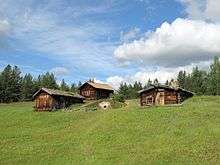
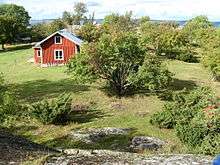
Traces of human activity are presented in many national parks.
Finland is sparsely populated, but that does not mean large areas would be untouched by man. The Finnish word for wilderness is "erämaa", which also means hunting grounds. People ventured far from their village to hunt and fish. Settling new areas was often encouraged by the crown and some landless people and adventurers built their home in what still is regarded wilderness. And, of course, only some of the national parks are wilderness. Some have been regularly used, but have had some feature hindering extensive logging or turning them to farmland. In Lapland in the far north, where there are truly large national parks and wilderness areas, most land is still used for reindeer husbandry, introduced in large scale by Northern Sami. The statutes of national parks often explicitly encourage traditional livelihood. The most prominent example is probably the Archipelago Sea National Park, where the park is trying to help keeping the archipelago inhabited.
Historical sites
There are often traces of the normal lives of people of the past: cultural landscapes kept open by grassing cattle, forest formed by slash-and-burn farming, sometimes remnants of farms, or even well preserved ones. Some trails have a long history, such as the Ruija trail, used to get to the Barents Sea coast before there were roads, or the post route in Muotkatunturit. In many parks by the east border there are structures remaining from the war.
The visitors centres
Most visitor centres have exhibitions that can be seen for free, in a few cases for a fee. Some are quite large. Groups can book guiding for a fee, sometimes it is also possible to join a regular guided tour. There are often also audiovisual shows, at regular intervals or at request, and nature trails. The personnel should be happy to give advice on what sights would suite your timetable and interests.
The Metsähallitus customer service points and nature information huts are more modest but sometimes really worth a visit. Some information huts are unmanned.
Do
Hiking in the Nordic countries has advice on many topics relevant for visiting national parks or otherwise spending time in the Finnish nature.
There are many businesses arranging tours in national parks or at other destinations, usually trying to pack many different experiences in a day or a few days. This may involve hiking to a hut where dinner is served, sitting down to enjoy the silence at a lake shore and ending the day with roasting salmon at open fire listening to local legends and lastly having a sauna bath and a dip in the river. Programme of course differs between locations and depending on the tour organizer and your choices. Usually you could do most of it by yourself, but getting it all fit a tight schedule without knowing the location is difficult.
With more time at hand or going independently you will probably come closer to the experiences many Finns seek in the forest and fells. Slow down, immerse in the natural landscape, enjoy the silence. You can also roast your salmon, but only if you were lucky with your lure, otherwise to have a good dinner you should have packed what you need to make hiking food something special, and the sauna is doubly refreshing after a few days of trekking.
Tours can be tailored to your wishes, but then it helps to be many enough to afford paying a guide – or to be able to do some of it by yourselves. You could for example take a tour with a river boat, having coffee and sandwiches with the guide telling the local legends, continue the trek by the route he recommended, and return to his cottage village to get the dinner and sauna.


- Hiking. In the small national parks of southern Finland the hiking trails are usually suitable for day trips or a weekend. In the larger parks and wilderness areas many go hiking for a week. There are longer trails also in the south, extending outside the protected areas.
- Skiing. In winter there are skiing tracks at least in most national parks and hiking areas. Plenty of backcountry remains for wilderness back-packers making their own tracks. See Cross-country skiing.
- Canoeing. At parks with a suitable waterway there are usually small businesses that can rent a canoe, give advice and take care of any arrangements. Depending on destination, options can include whitewater sports, more quiet canoeing and sea kayaking.
- Boating. Several parks have parts best accessed by boat.
- There are tour boats in some parks. In parks with a suitable river a riverboat may be the best way to get around or to get to your trailhead.
- Cruising with a yacht. At the coast and the bigger lakes (especially the Saimaa complex) chartering a yacht or getting a guided tour with a taxi boat should be easy. See also Boating on the Baltic Sea, which includes advice for lake destinations.
- Rowing boats are included in the rent of some cottages and can be rented at some other.
- Fishing. In most areas it is possible to fish. Except in flowing waters rich in salmon or related species, or otherwise restricted areas, rod and hook fishing (without reel) and ice fishing (angling through the ice) is an Every man's right, i.e. free. For lure fishing you need to pay the national fishing fee and for some areas an additional fee. For waters rich in salmon day cards are used (in addition to the national fee) and local restrictions apply. Catch and release fishing is not practised. Check minimal sizes.
- Gold panning. In Lemmenjoki National Park, in Tankavaara and perhaps at some other locations in Lapland you can get a possibility to try your luck in panning gold, or meet people spending their holiday digging gold. There were gold rushes in the middle 19th and 20th centuries, the traditions remain. The gold of Lapland is unusually pure, larger pieces often used as jewellery with just fittings added.
- Mushroom gathering and berry picking for food are included in the Every man's rights, often not restricted even when taking other things is strictly forbidden. This allows varying your menus on longer hikes and is a nice pastime regardless. Be sure to know the species you intend to eat and beware of poisonous mushrooms unknown where you come from. This is less of a problem with berries, but there are still some poisonous ones.
- Sauna bathing. There are saunas at many lakeside huts and cottages, even at some open wilderness huts. In the wilderness you are supposed to heat the sauna yourself, at commercial lodging facilities probably not – or at least you get help if needed.
Eat and drink
Local family businesses near the destinations often offer meals, lodging, tours, equipment and other service. Near some destinations there are also proper restaurants. At most destinations you will not find any meals or drinks inside the area, other than what you cook yourself – or have a wilderness guide prepare for you (also without a guide you may be able to have a local business bring you meals).
Picking edible mushrooms and berries is often allowed also when collecting other things is strictly forbidden. Make sure you know the ones you are going to pick and – at least for mushroom – any local doppelgangers. Fishing is often allowed, with the usual restrictions or requiring a local fishing permit. Hunting is allowed in the wilderness areas, given needed licences and paying for a permit (usually for small game only).
Good looking water in springs, streams and even lakes is often potable untreated, but boiling it for a few minutes may be recommended. In some areas water has to be brought. There may be wells or other water sources provided. The authorities make tests to evaluate the general quality of natural water in many of the areas, but give no guaranties, except where a specific water source has been tested and recommended (typically tap water or a well).
There are designated camp fire places in many areas, allowing cooking at the camp fire. Making open fire in Finland always requires permission of the landowner (use your own judgement in emergencies). Such permission is given for the built campfire sites at official destinations, for state owned backcountry in the wilderness areas and for some backcountry areas in national parks (check rules for the specific destinations and use established fireplaces where available). There are stoves in the wilderness huts. A camping stove is still recommended for any serious hiking.
Making open fire is always forbidden when a wildfire warning is in effect, or the fire otherwise risks spreading. Have enough water at hand.
The permission to make a fire does not in itself include a right to take firewood; at huts and campfire sites firewood is provided for free, usually in a separate wood shed (sometimes a shed some distance from the fireplace, to avoid excess use). Use sparingly. If not all the firewood is ready made, use the provided axe (or your own) to make some more instead of what you use. Likewise, take firewood indoors instead of what you use in huts. Where making a fire is allowed in the backcountry, permission is usually also given for using dry twigs and branches on the ground.
There are pit toilets at most huts and at some shelters. You may need to have your own toilet paper.
Sleep
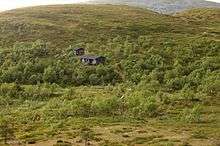
There are lots of commercial lodging facilities near at least some popular parks – but if you are going to spend more than a day in the park, you should look also at other options.
At the hiking destinations in northern Finland there are open wilderness huts providing accommodation for free. You need about the same equipment as when sleeping in tents, but will be able to get warm and dry as you have got the fire going, and sometimes even have the luxury of a gas stove for cooking or of a sauna bath (do not even think about electricity or running water; have some candles for light in autumn and winter). Latecomers have an absolute right to the facilities; those who already had a chance to get warm have to arrange room, by leaving if necessary. Especially in popular areas the nearest open wilderness huts are often a day's hike from any trailheads.
In popular areas there are also reservation huts, where you get a guaranteed bed, usually with blanket, mattress and pillow, for about €10 (use own linen). Usually you get (and leave) the key at the visitor centre or some nearby business. Bigger and commercial parties should use this option, as should people with snowmobiles.
Some of the less popular wilderness huts have been transformed into rental huts, which are booked for a party, often for somewhat longer periods, e.g. as a base for fishing trips in the area. They might have a rowing boat, sauna and similar.
Also day huts can be used for overnight stay, in cases where your primary plans get upset, e.g. by a snow storm.
Beside the normal "huts", which are small houses, there are more primitive turf huts and Lap pole tents, the former partly dug into the ground and with a roof made of turf, the latter timber constructions with or without a plank floor. In most you have to sleep on the floor (i.e. mostly the ground). There may be a fireplace instead of a stove.
All the huts work mainly by self service. Check instructions (there is a folder in most huts) and leave the hut as you would like to find it. Note your visit in the guest book (there are guest books also at many shelters).
Going to the south, open wilderness huts get sparse. As winters are less severe here, you can get away without them. Instead there are lean-to shelters, where you can spend the evening by a campfire and get shelter from rain in the night.
The main option is of course a tent. You might want to carry one even if you plan to use huts, especially in peak season (get warm and dry in the hut, but sleep in the tent, if you suspect another party may arrive later) or hiking in severe conditions (where you might not reach the hut before dark). In spring and autumn (when the conditions are mild and there are no or few mosquitoes even in the night) a tarp tent or similar shelter can be used instead of a tent.
There are seldom proper camping areas in the parks. Instead you can put your tent near provided infrastructure, such as open wilderness huts and campfire places. In some busy parks only designated areas are to be used, but the facilities are similar. In the backcountry of larger parks you can usually put your tent anywhere but in a few restricted areas.
When visiting smaller areas without facilities, you can still use your tent: sleeping in the wood outside the area for a night or two is allowed by the right to access, provided due consideration.
Stay safe and healthy

Keep warm and afloat. In remote areas you will not be able to get any quick help in emergencies, so know your limits and prepare well for anything demanding. Remember mobile phone coverage may be poor in some areas.
Dangerous encounters with animals are rare. The European adder is the only poisonous snake (see Finland for advice). There are bears and wolves, especially in eastern Finland, but they avoid humans. As long as you do not manage to get between a bear and her cubs or let your dog find and provoke a bear, you should be pretty safe (they have not learnt to come after your food).
The ticks carry Lyme disease or TBE in some areas, both potentially nasty. You might want to take precautions.
Mosquitoes are a non-trivial nuisance in many of the areas in summer, especially in the north and by wetlands. Hundreds of stings may even make you ill. Make sure you have plenty of repellent at hand, a hat with a mosquito net (in the worst areas) and a mosquito proof tent. Black flies (breeding in streams, not still water, and thus more common in the north) are even worse, as they will find any small hole in your protection.
Another little beast, which can drive people crazy, is the deer fly (hirvikärpänen, älgfluga). This poor flat fly crawls around in your hair and clothing in the hopeless quest of finding the deer in you. After having cut off its wings it has no choice but to continue, even realizing its mistake. They are harmless and seldom bite humans, but rather difficult to chase away or squeeze.
Go next
- Norwegian or Swedish National Parks or – for the adventurous – the Russian taiga or tundra.

